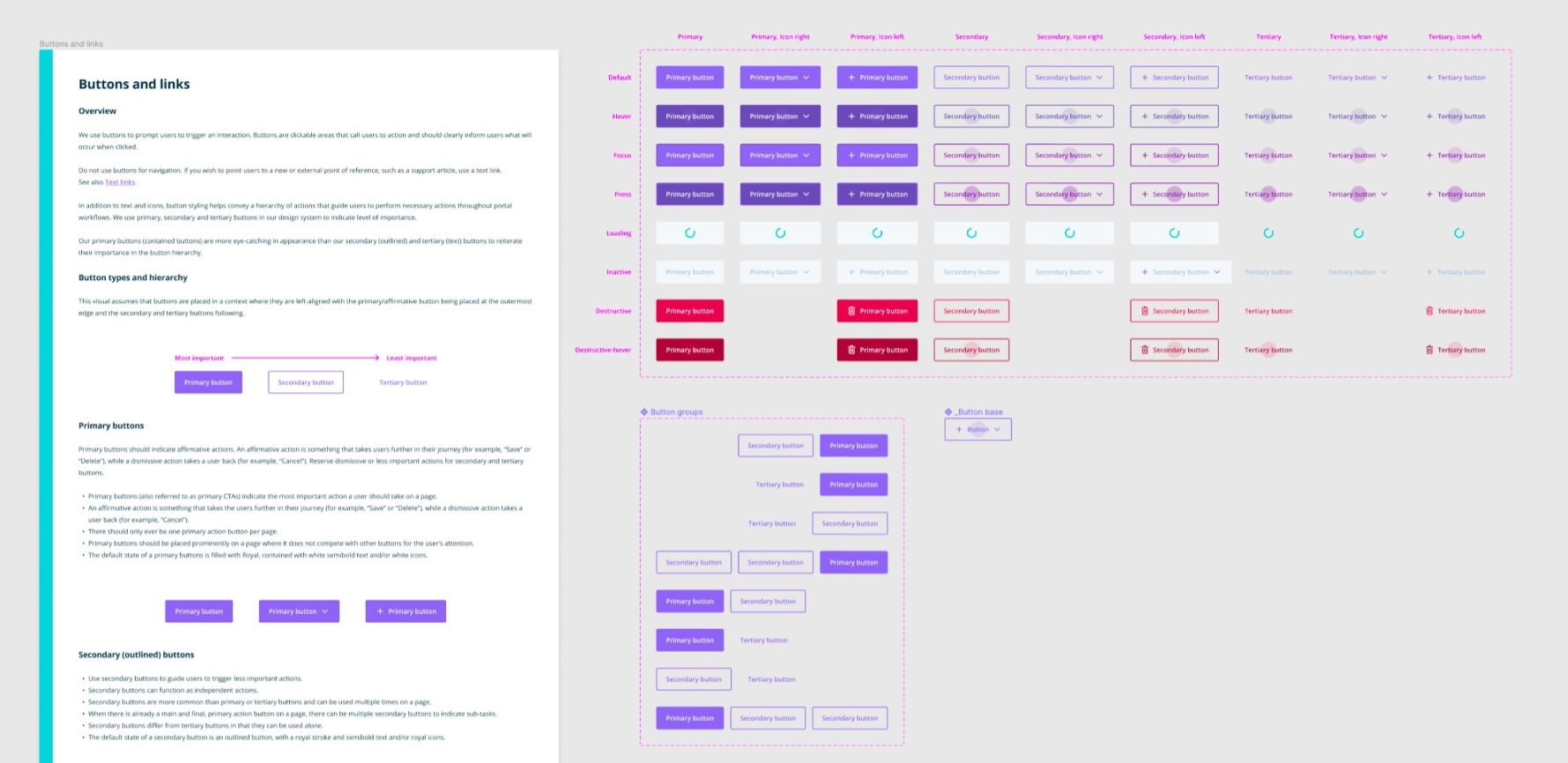Unicorn Design System
When I joined WP Engine as one of three product designers, our design system was holding us back. As the team grew rapidly, the cracks became impossible to ignore: designers detached components because states were missing, engineers built without a shared library, and new hires struggled without documentation.
I led the effort to rebuild our design system from the ground up—not just creating better components, but fundamentally changing how we scaled design across the organization. The result: a comprehensive, accessible design system with embedded documentation that became the foundation for all WP Engine product experiences.
My Role & Approach
I led the end-to-end design system consolidation effort while managing a team of two contributing designers, which included:
Team leadership: Managing two designers, reviewing their contributions, and providing design feedback
Strategic planning: Auditing existing components and establishing governance models
Design leadership: Creating atomic components using Figma's auto layout and variants
Accessibility champion: Implementing WCAG 2.1 AA compliance standards
Documentation: Writing usage guidelines embedded directly in the design library
Cross-functional collaboration: Partnering with engineering and product on implementation
Quality assurance: Conducting final design QA before production deployment
Understanding the Problem
Visual Audit & Research
Before designing solutions, I partnered with another designer to conduct a comprehensive audit of the existing User Portal, documenting every button, header, color, and interaction pattern to identify inconsistencies.
We then collaborated with our UX research team to gather qualitative insights:
Surveyed designers and developers about their use of the existing system (Unicorn Design System)
Conducted moderated interviews to understand pain points and knowledge gaps
Identified priority areas for improvement based on frequency of use and impact
Key Findings:
Designers regularly detached components from the library due to missing states
No single source of truth for design patterns or usage guidelines
Documentation existed but was buried in Confluence and rarely consulted
Engineering lacked a unified component library, creating drift between design and implementation
Atomic Design at Scale
Foundation First
Inspired by Brad Frost's Atomic Design methodology, I established a scalable architecture starting with design foundations:
Typography system with clear hierarchy and accessibility considerations
Color palette with WCAG AA compliant contrast ratios
Spacing scale using consistent 8px grid system
Accessibility guidelines embedded throughout
Component Development
Inspired by Brad Frost's Atomic Design methodology, I established a scalable architecture starting with design foundations:
Typography system with clear hierarchy and accessibility considerations
Color palette with WCAG AA compliant contrast ratios
Spacing scale using consistent 8px grid system
Accessibility guidelines embedded throughout
Documentation Where Designers Actually Work
A critical insight from our research: designers weren't reading documentation in Confluence because it meant context-switching away from their primary tool.
Solution: I embedded usage guidelines directly within the Figma library file.
Benefits of this approach:
Always accessible: Designers keep the library file open as they work
Stays current: Updates happen in one place as components evolve
Developer visibility: Using Figma's Storybook integration, we "iframed" guidelines alongside React components, giving engineers the same context
Each component included:
Usage guidance and best practices
Anatomy breakdowns with labeled parts
Do's and don'ts with visual examples
Accessibility requirements
Links to corresponding Storybook implementation
Accessibility by Design
Rather than retrofitting accessibility, I made WCAG 2.1 AA compliance a core requirement:
All color combinations tested for contrast ratios
Focus states clearly visible for keyboard navigation
Proper semantic structure in component naming
Screen reader considerations documented
Collaborated with engineering to ensure implementation matched accessibility intent
Managing the Transition
The Deprecation Challenge
Migrating from old components to new variants presented a unique challenge in Figma: deleting components defaults them to the last version rather than removing them, creating an invisible inconsistency.
My solution: A clear deprecation strategy
Added visual indicators (translucent striped pattern in "Notes" pink) to deprecated components
Updated layer naming with [DEPRECATED] labels
Only marked components deprecated after new versions shipped to Storybook
Created migration guides for designers working in legacy areas of the Portal
This approach maintained backward compatibility while clearly signaling the path forward.
Scaling Through Contribution
While I led the system with two other core contributors, I recognized that long-term success required enabling the entire design team to contribute while maintaining quality and coherence.
I developed:
Contribution guidelines outlining when to contribute vs. when to use existing patterns
Proposal template for suggesting new components or modifications
Walkthrough guide documenting the end-to-end process from design to Storybook
Governance model with clear approval workflows and design QA checkpoints
This empowered designers to solve problems with system-thinking while preventing fragmentation.
Impact & Outcomes
Results
Reduced design inconsistency across the User Portal through standardized components
Accelerated development velocity by providing engineers with a unified React component library
Improved accessibility by embedding WCAG 2.1 AA standards into every component
Scaled design team effectively through comprehensive documentation and contribution models
Eliminated tribal knowledge dependency by making guidelines accessible in designers' primary workflow
Team Benefits
Designers onboarded faster with clear documentation and examples
Engineers implemented designs with greater accuracy and consistency
Product managers gained confidence in design scalability
QA cycles shortened due to standardized component behavior
